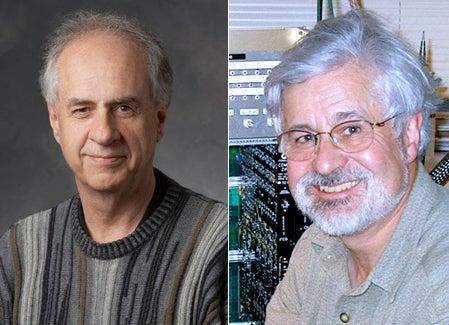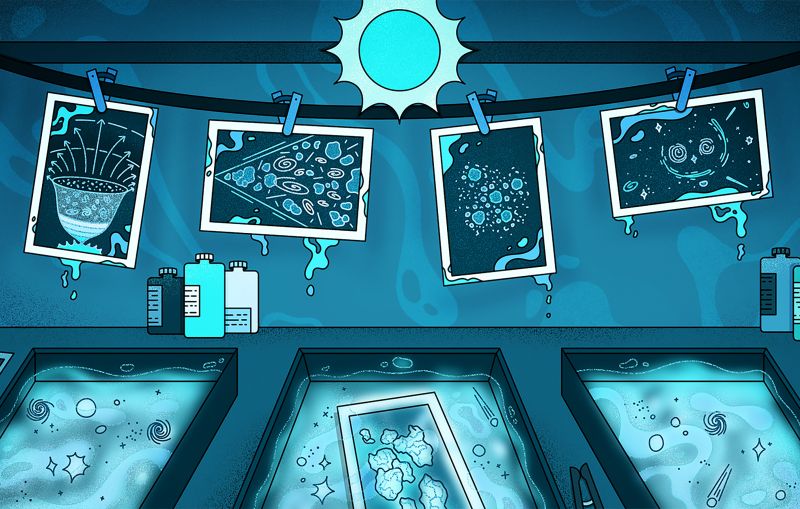Panofsky Prize Honors Researchers' Underground Hunt for Dark Matter
The search for dark matter runs deep with physicists Blas Cabrera and Bernard Sadoulet, who have chased this mystery far underground and will be recognized for their work as joint recipients of the 2013 W.K.H. Panofsky Prize in Experimental Particle Physics.
By Glenn Roberts Jr.
The search for dark matter runs deep with physicists Blas Cabrera and Bernard Sadoulet, who have chased this mystery far underground and will be recognized for their work as joint recipients of the 2013 W.K.H. Panofsky Prize in Experimental Particle Physics. The prize is named for SLAC's founding director, Wolfgang "Pief" Panofsky, and awarded by the American Physical Society.
While some researchers are scanning the heavens with powerful telescopes to detect dark matter or crashing particles together in an effort to create and study its exotic components, Sadoulet, of the University of California, Berkeley, and Lawrence Berkeley National Laboratory, and Cabrera, of Stanford University and SLAC National Accelerator Laboratory, have sought the same answers in deep shafts largely shielded from cosmic rays and other unwanted particle "noise."
Their continuing, decades-long Cryogenic Dark Matter Search has brought them to several underground sites in the hunt for direct evidence of theorized weakly interacting massive particles, or WIMPs. If they are proven to exist, WIMPs could help define and explain dark matter, which is thought to make up about 25 percent of the energy density in the universe and is responsible for the formation of structure in the universe.
This, in turn, could improve our understanding of the evolution of the universe and our interpretation and analysis of astronomical observations.
Cabrera, a physics professor at Stanford with a term appointment within the SLAC Particle Physics and Astrophysics faculty, said the prize, which includes a $10,000 award and a certificate citing the recipients' scientific contributions, is gratifying, and it's "wonderful to share it" with Sadoulet. "We have been leaders of the Cryogenic Dark Matter Search work for many years,” he said.
He added, "It's also nice to have the tie with Panofsky, who I knew and deeply admired for many years."
Sadoulet, a UC Berkeley physics professor and director of the UC Institute for Nuclear/Particle Astrophysics and Cosmology, said, "Working in a tight collaboration with Blas Cabrera has been very rewarding. I am particularly pleased to receive a prize named after Pief Panofsky, with whom I had a number of formative interactions as a young physicist.”
2012 APS President Robert L. Byer, co-director of the Stanford Photonics Research Center, sent a letter to Cabrera and Sadoulet that included the citation for the prize, which recognized "their pioneering work and leading roles in the development and use of phonon-detection techniques enabling direct searches for weakly interacting massive particles."
Established in 1985, the annual prize is intended to "recognize and encourage outstanding achievements in experimental particle physics." The 2012 prize went to physicist William B. Atwood of the University of California, Santa Cruz, who has been instrumental in the Fermi Gamma-ray Space Telescope collaboration.
Cabrera credited a strong collaboration, including participation from scientists at SLAC and other national labs, for progress in CDMS. "We've been working on these types of technologies since the late 1980s, and there's been a close collaboration since the early 1990s,” he said.
"Our low-temperature technology, based on the simultaneous detection of phonons and ionization, has very high signal to noise and should be able to identify a signal, if it exists," Sadoulet added. "In the last 10 years, there has also been impressive progress with noble liquids, which provide a technology complementary to the approach that we pioneered."
WIMPs have so far eluded detection, but Cabrera said the detector technologies are improving to a level that researchers should be able to either find proof of WIMPs or rule out their existence. Either scenario would represent an important scientific advance.
"What it is that makes up dark matter is one of the most exciting questions in science," Cabrera said. "We are always wanting, just around the corner, to be able to see a signal. We have to have patience and conviction and stick with it, so that's what we've done."
Notably, the detector sensitivity has improved more than 10,000-fold in the past 20 years, and Cabrera said he expects continuing improvements. Also, researchers have continued to go deeper underground with successive generations of experiments to better isolate the detectors from disruptive particles.
"The technologies we've developed have dramatically improved the instruments in other research areas, including X-ray spectroscopy, X-ray astrophysics and studies of the cosmic-microwave background," Cabrera said. "It has been satisfying to see the scientific spinoffs."
CDMS experiments began at an underground site at Stanford, where they ran through the 1990s and into the early 2000s, and then moved to a former commercial mining site in Minnesota that had been transformed into the Soudan Underground Laboratory.
There is active research and development to move the experiments to a deeper site, dubbed SuperCDMS-SNOLAB, at an active mine in Sudbury, Canada, using a larger array of more sensitive detectors placed at a depth of about 6,800 feet – compared to about 2,600 feet for the current set of experiments.
SLAC researchers, led by Richard Partridge, SLAC's CDMS department head and a project scientist, are playing a leading role in the research and development effort for new, larger CDMS detectors.
"Bernard and Blas are the Lewis and Clark in the quest for detecting dark matter," Partridge said of their CDMS work. "Many of their former students and postdocs are now leaders in the field, and it has been a great experience working with them and following the trail they have blazed."
Daniel A. Bauer, CDMS project director and deputy head of the Center for Particle Physics at Fermilab, noted that Cabrera and Sadoulet "led the CDMS collaboration from its inception and are rightly considered as founding members of the dark matter direct-detection community."
"Their deep understanding of solid-state detectors has kept the CDMS technology as a leader in the battle against backgrounds that would otherwise overwhelm dark-matter signals," Bauer added. "It has been my pleasure to work with both of them."
Contact
For questions or comments, contact the SLAC Office of Communications at communications@slac.stanford.edu.






